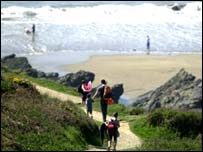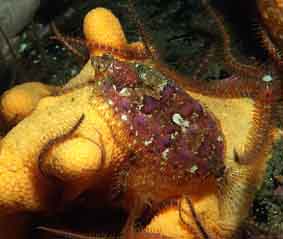MLSSA
Newsletter
OCTOBER 2003
No. 304
Next Meeting
Our meeting will be held at the Conservation Centre, 120 Wakefield Street, Adelaide on Wednesday 15th October commencing at 7.30pm.
Our main speaker will be Ian Whittington whose talk is titled "Plenty of fish in the sea: oh! but what about their parasites?"
Don Staniford (an environmental campaigner based in the UK ) will speak after Ian on the subject of Aquaculture.
Contents
British beaches ‘gone within 100 years’
Heidi Bartram Update
New Seahorse Discovery
Society Library An Important Resource
BMLSS picture gallery
The Story of Seafood
Threat to Grey Whales
This month our contributors are Alex Gaut, Philip Hall, the BMLSS and Steve Reynolds.
Newsletter Articles
In order to provide a wide variety of views and experiences to members and other readers, I need a fresh supply of articles for future Newsletters. Please put pen to paper asap. As Steve will tell you I sometimes hold articles for many months in order to find an appropriate time to publish them.
Philip Hall (Editor)
British beaches ‘gone within 100 years’
By Helen Briggs
BBC News Online science reporter http://news.bbc.co.uk/
Climate change is changing the face of the British coastline, eroding beaches and marshes.
Conservationists warn that if nothing is done, holiday beaches may be lost within 100 years along with habitat that shelters wildlife.
International experts are meeting in London on Wednesday to discuss ways to protect the UK's coastal assets.
It depends on working with nature rather than against it, say experts from "Living with the Sea", a four-year European partnership headed by English Nature.
"For many centuries we’ve over-engineered our coast and now in the face of unstoppable sea level rise we have to think of all coastal management options," says Stephen Worrall of Living with the Sea.
"We have to work with nature and not fight nature on the coast."
"It means allowing the sea back into some of the undeveloped frontages such as farmland."

Many beaches are disappearing
Hard engineering
Living with the Sea says a rise in sea levels driven by climate change has already altered the coastal landscape around the UK. (The south of England is of particular concern because it has been gradually sinking compared with the north since the last ice age.)
Resorts like Weymouth in Dorset have been robbed of sand while vast tracts of salt marsh have disappeared in counties such as Essex.
It appears that concrete and steel defences put up to protect land from erosion and flooding are putting beaches and other marine environments under pressure.
Sand dunes and marshes naturally shift inland as sea levels rise but are unable to do so if they meet a hard barrier.
These "hard-engineering" solutions could radically change the appearance of beaches for future generations, impoverishing coastal wildlife, says the partnership (which also includes the Environment Agency and the Department for Environment, Food and Rural Affairs).

Beaches have changed over the years
Restoring habitat
The habitat of the two million water birds that spend the winter in the UK is at risk, says the Royal Society for the Protection of Birds (RSPB).
"There will come a time when if you don’t give way to the sea you will be left with a huge problem," says spokesman Grahame Madge.
"You have to recreate these habitats inland if you’re to protect them."
The RSPB says it is possible to restore inter-tidal habitat by resetting sea defences, as a pilot scheme at Freiston Shore Nature Reserve in Lincolnshire has shown.
A flood defence was erected inland and the sea was allowed to breach the original sea wall, allowing birds and other wildlife to thrive.
Submitted by Alex Gaut
Heidi Bartram Update
Tony and Phyll Bartram say that their daughter Heidi is currently in Vanuatu for a year as a Youth Ambassador in Fisheries and having a challenging and wonderful time. She will be back next March. Heidi Bartram was the guest speaker at our August 2002 meeting. She mainly spoke about her work in the Environment Team for the National Youth Roundtable, a Commonwealth Youth Initiative. We hope to have Heidi return to bring us up to date when she is back in South Australia. In the meantime we wish her good luck in Vanuatu.
Steve Reynolds
New Seahorse Discovery
According to "Sea-River Newsletter No.109", a new species of seahorse has been discovered by Sara Lourie from the University McGill in Montreal, Canada. The seahorse lives in the coral zones of Indonesia at a depth of 2 to 90 metres. It is only13 to 16 mm in length, making it the smallest fish discovered in the world. It has been given the scientific name of Hippocampus denise.
Steve Reynolds
Society Library An Important Resource
Our Society library recently proved itself as an important resource when we received an enquiry from overseas. We received an email request from Gitte Moller of the library at the Danish Institute for Fisheries Research in Denmark. Gitte said that the Institute’s library wanted a copy of a report in our library. It was the "Marine Fish and the IUCN Red List of Threatened Animals" (MLSSA No.2030A). Gitte said that they had been unable to find any other reference to the report on the Internet other than on our MLSSA website. I contacted Gitte to say that I could send the relevant parts of the report. Gitte replied to say that the scientist requesting the report wanted to receive a complete copy. I duly copied the whole report and sent it off to Denmark. Below is the information about the report that the Institute found on our website: -
"Marine Fish and the IUCN Red List of Threatened Animals" edited by E. Hudson & G. Mace - a report of a workshop held in collaboration with WWF and IUCN in 1996. The Red List includes 148 species of marine fish, 80% (118) of which have been classified as threatened. 70% (83) of these 118 have been classified as declining in population. The list includes some SA species as follows: - Big-bellied Seahorse, Short-headed Seahorse, Sculptured Seamoth, Robust Pipehorse, Spiny Pipehorse, Leafy Seadragon and Weedy Seadragon. The seadragons and Short-headed seahorse are classified as being "Data Deficient" - MLSSA No.2030A
Steve Reynolds
BMLSS PICTURE GALLERY
http://www.glaucus.org.uk/
Each month, at least one special marine image is published from images sent to the BMLSS. This can be of the seashore, undersea world or any aspect of the marine natural world, especially the underwater life, but not restricted to life beneath the waves.
1 July 2003
Seeing five of these on one dive last weekend at St. Abbs reminded me how common these fish are in the North Sea despite just about every identification book saying they are restricted to western and southern coasts. They are probably overlooked because they are small (about 9 cm seems typical), restricted to rocky areas above 20 metres depth (at least from my observations) and have phenomenal camouflage ability. They are very difficult to see unless they move. On "normal" brown rock, they are brown and blend in perfectly. The picture (see below) shows one that had just moved off a rock that was spotted with encrusting purple algae giving some idea of what colours they are capable of adopting.

Norwegian Topknot, Phrynorhombus norvegicus.
St. Abbs Marine
Reserve. SE Scotland.
Photograph - Jim Greenfield

MLSSA Library
Above is a picture of the front cover of a new book that has recently been added to the MLSSA library.
On Friday 22nd August Philip and Margaret Hall attended its launch at the Star of the Sea Marine Discovery Centre at Henley Beach.
It was launched by Senaror Ian Macdonald the Federal Minister for fisheries and Minister Paul Holloway the State Minister for Fisheries. Other State and Federal politicians attended as well as Robert DeCastella and representatives of the Fisheries Department and Michael Angelakis who cooked various seafood for us to sample.
The book is an excellent overview of fish and fisheries and is beautifully illustrated throughout.
It is available for loan from the MLSSA library on application to the Librarian - Steve Reynolds.
Philip Hall
Threat To Gray Whales
William Wilgus, Director of The Public Cause, recently informed us about an experiment that will expose up to 3,000 migrating Gray Whales---more than 20 percent of the total number---to very loud sounds. The experiment is being conducted by Dr. Peter Tyack on behalf of the U.S. Navy, and was scheduled to begin on January 8th 2003.
Tyack will expose the whales to low (766--965 Hz, or cycles per second) and high frequency (10,000 Hz or above) sounds AT HIGH SOUND LEVELS, up to 180 dB according to Dr. Tyack------256 times more loud than the level that causes pain in humans. The animals will have a receiving device temporarily attached to them by suction cups to receive and record the sound data and record the whales' responses to the sounds.
The National Marine and Fisheries Service (NMFS), which has the duty to enforce the Marine Mammal Protection Act (MMPA), concluded that no Environmental Assessment would be necessary to review Tyack’s request to conduct the experiment and granted the ‘take permit’ necessary under the MMPA for him to do so. However, the number of Gray Whales has been declining worldwide, and here's what renowned expert Dr. Lindy Weilgart had to say about migrating whales in Dick Russell’s ‘Eye of the Whale’:
"Anything that has the potential to change, even slightly, a whole population of migrating whales should be viewed with extreme caution. If something serious befalls these migrating animals, it means that the whole population is doomed."
In fact, the U.S. Delegation to the IWC meeting in Japan gave evidence that the Gray Whale population had declined by 9,000, that calf numbers were down by 80 percent (in 2000) and that the latest estimates showed that there was NO recovery in calves and the number of adults continued to decline.
How all this came about was that Tyack's original request was for sound levels of 140 dB, which was granted. He later filed an amended request for sound levels of 160 dB, and this was granted as well. Later still, he filed a further amended request to use sound levels of 180 dB, and this---the current permit---was granted. In view of the information in the preceding and following paragraphs, issuing the amended permits---especially the last for 180 dB---without an environmental assessment was particularly foolhardy.
Sounds at levels 322 times LOWER (155 dB) from U.S. Navy SONARs caused the deaths of multiple beaked whales in the Bahamas during March of 2000; sounds at levels 1,048,576 times lower (120 dB) are known to have caused behavioural changes in the whales and can interfere with their ability to communicate, and this is especially true for mother/calf communications. The effect of sound on whales fetuses and newborn calves is unknown, and since the whales will be returning from their breeding grounds, the experiment presents grave risk to future whale populations. However, it's clear from the experiment methodology description that the sound levels they may be exposed to could be considerably higher!
When I submitted the above article to Philip he queried the part reading "sounds at levels 1,048,576 times lower (120 dB) are known to have caused behavioural changes". He was concerned about the large figure quoted and asked me to have it confirmed. I contacted William Wilgus who replied as follows:-
Thanks for your inquiry, Steve.
Yes, I confirm the figure of 1,048,576. The decibel scale, which is logarithmic and therefore non-linear, is used with sound levels because of the extremely large numbers that would be necessary with a linear scale. How loud a sound is DOUBLES every 3 dB; the way to calculate relative loudness is to calculate the power of two (2) raised to the ((Sound Level 1 - Sound Level 2) / 3) power. In this case the term is power (2, ((180 - 120) / 3)) = 1,048,576
The question was no doubt prompted in part by the ‘256 times more loud’ statement. The sound level usually given for causing pain in humans IN AIR is 130 dB (a few give it at 125 dB); the sound levels for the experiment are IN WATER. Due to the difference in density between air and water, it’s necessary to ‘adjust’ sound levels in water to those in air, and the adjustment is made by SUBTRACTING 26 from the sound level in water. Therefore, the calculation would be as follows:
Power (2, (((180 - 26) - 130) / 3)) = 256
(If 125 dB were taken as the ‘threshold of pain’, the result would be 812.75.)
Due to personal experiences with loud sounds, I think it’s rather difficult for most to believe that loud sounds in water can cause physical harm in addition to harming hearing systems. The answer why it can do so is related to the fact that most living organisms are mostly comprised of water (about 98%). How much sound energy is transferred to an object within a medium carrying sound is determined by the relative sound ‘impedance’ (or ‘resistance’ to ‘carrying’ sound) of the medium and the object. Air has a large sound impedance difference with living things, and only about two (2) percent of the sound can be transferred into the life form. Water has a very small sound impedance difference with life forms, and about 98 percent of the sound can be transferred into them. Sound is of course a form of energy, and it's known that it can cause physiological harm to living beings through two mechanisms:
1. Body Cavity Resonance. All objects have a natural resonant frequency at which they can easily be made to vibrate, and if a sound at or near that frequency is strong enough, the object will be made to vibrate. With sufficient amplitude of vibration, the structure of that object---in this case tissue---will be torn or ripped.
2. Rectified Diffusion. Sound is capable of causing gases dissolved in liquids to ‘come out solution’ and form gas bubbles within the liquid. Gas bubbles forming in the blood of a diver is the cause of De-Compression Sickness, which is better known as the ‘Diver’s Bends’. The effects of DCS are numerous and vary from case to case. Dis-orientation is perhaps the minimum; death---either immediate or at some future time---is the maximum. If cavitation occurs---the rapid collapse of the gas bubbles---damage to surrounding tissue is inevitable.
Sound can also cause psychological harm as well. Among other things it’s known that continued exposure to sound can cause emotional changes and stress. Stress, of course, has its own debilitating effects, including a decreased resistance to illness.
Further information on the harm that underwater sound can and has caused to marine life is available at http://www.thepubliccause.net/LoudSONARs6.html. The page is one of 9 that deal with the issue of ‘Loud SONARs vs. Marine Life’.
I’d be more than happy to provide any further assistance.
Regards,
William Wilgus
The Public Cause Network
13400 NE 1st ST RD, Unit
2
Silver Springs. FL 34488-3900
USA
(352) 625-9646
William’s first email gave details of a pending court case regarding the experiments involving the Gray Whales. Those details were left out of this article for reasons of timing. William kept me posted on developments though and has now reported the following outcome.
"Federal Judge Samual Conti in San Francisco today entered a permanent
injunction stopping planned sonar testing on migrating Gray Whales off the coast
of California.
The judge had earlier entered a temporary restraining order
stopping the testing until a full hearing could be held.
Plaintiffs in the
case were the Hawai`i County Green Party, Australians for Animals, Stop LFAS
{low frequency active sonar} Worldwide Network, Channel Islands Animal
Protection Association, Robert Puddicombe, and Sea Sanctuary, Inc.
Defendants
included the Secretary of Commerce Donald L. Evans, other federal officials, and
Dr. Peter Tyack of Woods Hole Oceanographic Institute.
The judge based his
decision, in part, on the failure of the National Marine Fisheries Service
(NMFS) to perform any analysis of possible environmental impacts from the
testing and on the potential for the testing to harm Gray Whales.
NMFS had
claimed a "categorical exclusion" that allowed them to grant amendments to an
existing permit without conducting an environmental assessment.
Plaintiffs
argued that six different exceptions to this rule applied in this case.
Judge
Conti found the exclusion claim did not adequately consider a number of
exceptions that could have required preparation of an environmental analysis.
The ruling particularly found that an exception for public controversy
applied.
"Plaintiffs have proven that NMFS acted arbitrarily, capriciously,
and in a manner contrary to law when, during its review of the application for
the First Amended Permit and the Third Amended Permit, it decided not to apply
the exception to categorical exclusion relating to actions that are the subject
of public controversy."
The court further found that other exceptions may
have applied and the public controversy exception was so clear that there was no
need to even consider whether the other exceptions did apply.
The judge cited
two earlier cases in the same judicial district relating to acoustic testing on
marine mammals that had resulted in injunctions being issued.
The judge noted
that NMFS prepared an environmental assessment for the initial permit based
solely on the existence of such controversy. "The presence of the controversy
was obvious in 2000. It was also obvious in 2001 and in 2002 when NMFS was
considering Dr. Tyack’s applications for the First Amended Permit and the Third
Amended Permit. It is certainly no less
obvious today."
The ruling revoked
the first and third amendments to a permit granted in August 2000. The
amendments permitted additional activities, including the sonar testing on Gray
Whales. The revocation of the amendments also prevents the tagging of Humpback
Whales in Hawai`i and increasing the sound levels reaching the whales.
The
second amendment is a minor amendment that the court left in place.
The judge
found that the NMFS claim that no environmental analysis was necessary failed
because the absence of such analysis violated the National Environmental Policy
Act requirement to consider exceptions to the categorical exclusion rule and
posed a threat of harm to the Gray Whales.
The judge noted that the Third
Amended Permit allowed broadcast at levels received by the whales as high as 180
decibels. "The likely harm is pain and/or injury that marine mammals will suffer
when subjected to the sounds.
It cannot be doubted that the sound will, at
the very least, disturb the animals to whom they are broadcast."
The harm to
the Gray Whales could also come from broadcasts of sonar that overlapped the
hearing range of the Gray Whales.
In addition the court expressed concern
about the decline in the Gray Whale population to a level of below their number
at the time NMFS removed the Gray Whale from the Endangered and Threatened
List.
While the court noted that NMFS argued that the decline in the Gray
Whale population level is not serious, the court found that the issue was "to
say the least, debatable."
The court did not revoke the initial permit. That
permit still permits sonar testing at low, mid, and high frequency levels on
hundreds of thousands of marine mammals.
Lanny Sinkin, attorney for the
plaintiffs, said "We are thrilled that we were able to present sufficient
evidence in a very short period of time to convince the judge to revoke the NMFS
permits and stop Dr. Tyack’s experiments on Gray Whales. As a Hawaiian attorney,
I am also pleased the permit to tag Humpback Whales in Hawai`i was also
revoked."
The next step, according to Sinkin, is to file a petition with NMFS
to return the Gray Whales to the endangered list. "Sue Arnold of Australians for
Animals is drafting the relisting petition now and it should be filed within a
month."
For further information on the ruling, contact Lanny Sinkin (808)
982-5110
For further information on the crisis in the Gray Whale population,
contact Sue Arnold (650) 208-4628.
You can check out the web site for The Public Cause at:-
http://www.thepubliccause.net/
William Wilgus can be emailed at:-
Director@ThePublicCause.Net
Steve Reynolds